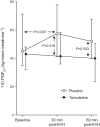A standard, single dose of inhaled terbutaline attenuates hyperpnea-induced bronchoconstriction and mast cell activation in athletes
- PMID: 26846550
- PMCID: PMC4894945
- DOI: 10.1152/japplphysiol.00700.2015
A standard, single dose of inhaled terbutaline attenuates hyperpnea-induced bronchoconstriction and mast cell activation in athletes
Abstract
Release of bronchoactive mediators from mast cells during exercise hyperpnea is a key factor in the pathophysiology of exercise-induced bronchoconstriction (EIB). Our aim was to investigate the effect of a standard, single dose of an inhaled β2-adrenoceptor agonist on mast cell activation in response to dry air hyperpnea in athletes with EIB. Twenty-seven athletes with EIB completed a randomized, double-blind, placebo-controlled, crossover study. Terbutaline (0.5 mg) or placebo was inhaled 15 min prior to 8 min of eucapnic voluntary hyperpnea (EVH) with dry air. Pre- and postbronchial challenge, urine samples were analyzed by enzyme immunoassay for 11β-prostaglandin F2α (11β-PGF2α). The maximum fall in forced expiratory volume in 1 s of 14 (12-20)% (median and interquartile range) following placebo was attenuated to 7 (5-9)% with the administration of terbutaline (P < 0.001). EVH caused a significant increase in 11β-PGF2α from 41 (27-57) ng/mmol creatinine at baseline to 58 (43-72) ng/mmol creatinine at its peak post-EVH following placebo (P = 0.002). The rise in 11β-PGF2α was inhibited with administration of terbutaline: 39 (28-44) ng/mmol creatinine at baseline vs. 40 (33-58) ng/mmol creatinine at its peak post-EVH (P = 0.118). These data provide novel in vivo evidence of mast cell stabilization following inhalation of a standard dose of terbutaline prior to bronchial provocation with EVH in athletes with EIB.
Keywords: eucapnic voluntary hyperpnea; exercise-induced bronchoconstriction; inhaled β2-agonist; prostaglandin D2.
Copyright © 2016 the American Physiological Society.
Figures



Similar articles
-
Self-reported Symptoms after Induced and Inhibited Bronchoconstriction in Athletes.Med Sci Sports Exerc. 2015 Oct;47(10):2005-13. doi: 10.1249/MSS.0000000000000646. Med Sci Sports Exerc. 2015. PMID: 25710876 Free PMC article. Clinical Trial.
-
Effect of terbutaline on hyperpnoea-induced bronchoconstriction and urinary club cell protein 16 in athletes.J Appl Physiol (1985). 2013 Nov;115(10):1450-6. doi: 10.1152/japplphysiol.00716.2013. Epub 2013 Sep 12. J Appl Physiol (1985). 2013. PMID: 24030662 Clinical Trial.
-
Exercise-induced dehydration alters pulmonary function but does not modify airway responsiveness to dry air in athletes with mild asthma.J Appl Physiol (1985). 2017 May 1;122(5):1329-1335. doi: 10.1152/japplphysiol.01114.2016. Epub 2017 Mar 9. J Appl Physiol (1985). 2017. PMID: 28280109 Free PMC article. Clinical Trial.
-
Eucapnic Voluntary Hyperpnea: Gold Standard for Diagnosing Exercise-Induced Bronchoconstriction in Athletes?Sports Med. 2016 Aug;46(8):1083-93. doi: 10.1007/s40279-016-0491-3. Sports Med. 2016. PMID: 27007599 Free PMC article. Review.
-
Assessment and prevention of exercise-induced bronchoconstriction.Br J Sports Med. 2012 May;46(6):391-6. doi: 10.1136/bjsports-2011-090810. Epub 2012 Jan 12. Br J Sports Med. 2012. PMID: 22247297 Review.
Cited by
-
Compact Eucapnic Voluntary Hyperpnoea Apparatus for Exercise-Induced Respiratory Disease Detection.Sensors (Basel). 2017 May 16;17(5):1139. doi: 10.3390/s17051139. Sensors (Basel). 2017. PMID: 28509868 Free PMC article.
-
Mast cell-neural interactions contribute to pain and itch.Immunol Rev. 2018 Mar;282(1):168-187. doi: 10.1111/imr.12622. Immunol Rev. 2018. PMID: 29431216 Free PMC article. Review.
-
Sex Differences in Exercise-Induced Bronchoconstriction in Athletes: A Systematic Review and Meta-Analysis.Int J Environ Res Public Health. 2020 Oct 5;17(19):7270. doi: 10.3390/ijerph17197270. Int J Environ Res Public Health. 2020. PMID: 33027929 Free PMC article.
-
The Effect of 400 µg Inhaled Salbutamol on 3 km Time Trial Performance in a Low Humidity Environment.J Sports Sci Med. 2017 Dec 1;16(4):581-588. eCollection 2017 Dec. J Sports Sci Med. 2017. PMID: 29238260 Free PMC article.
-
Muscle hypertrophic effect of inhaled beta2 -agonist is associated with augmented insulin-stimulated whole-body glucose disposal in young men.J Physiol. 2022 May;600(10):2345-2357. doi: 10.1113/JP282421. Epub 2022 Mar 16. J Physiol. 2022. PMID: 35218559 Free PMC article.
References
-
- Anderson SD, Caillaud C, Brannan J. Beta2-agonists and exercise-induced asthma. Clin Rev Allergy Immunol 31: 163–180, 2006. - PubMed
-
- Anderson SD, Daviskas E. The mechanism of exercise-induced asthma is . . . . J Allergy Clin Immunol 106: 453–459, 2000. - PubMed
-
- Anderson SD, Rozea PJ, Dolton R, Lindsay DA. Inhaled and oral bronchodilator therapy in exercise induced asthma. Aust NZ J Med 5: 544–550, 1975. - PubMed
-
- Anderson SD, Seale JP, Rozea P, Bandler L, Theobald G, Lindsay DA. Inhaled and oral salbutamol in exercise-induced asthma. Am Rev Respir Dis 114: 493–500, 1976. - PubMed
Publication types
MeSH terms
Substances
LinkOut - more resources
Full Text Sources
Other Literature Sources

